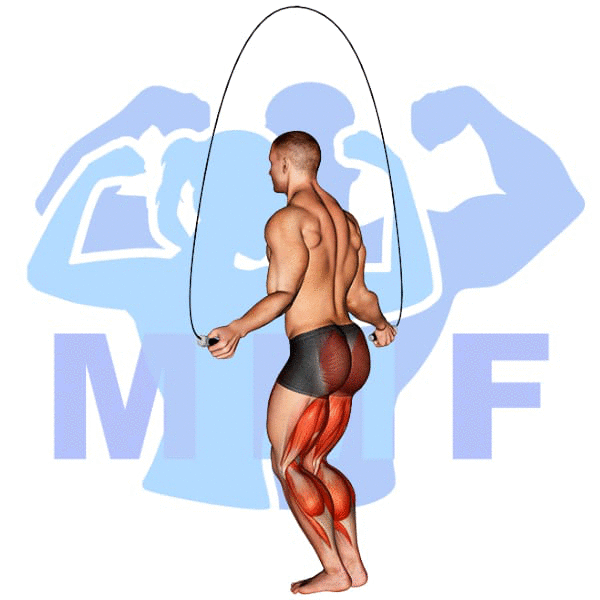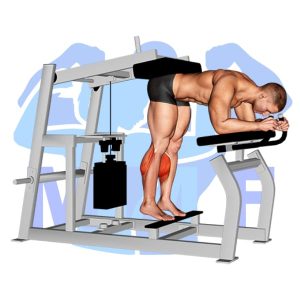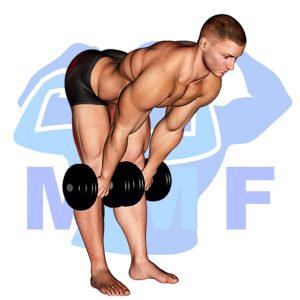Jump rope is a form of cardio that seems simple and fun. However, for many people, it can quickly become frustrating and discouraging. Does it sound familiar? You know the benefits of jump rope, but every time you pick up a rope, you get tripped up or tangled. Don’t worry, you’re not alone! Many beginners struggle with jump rope, and it’s understandable. In this blog post, I will go over the most common mistakes that beginners make and give you practical tips and techniques to jump rope like a pro. So, keep reading if you want to improve your cardio, coordination, and endurance with this simple and effective workout tool.
Jump Rope Summary
- Primary Muscles: Gastrocnemius
- Secondary Muscles: Gluteus Maximus, Quadriceps, Soleus, Wrist Extensor, and Wrist Flexor
- Equipment: Jump Rope
- Mechanics Type: Compound
- Force: Push
- Utility: Basic

Jump Rope Instructions
- Jumping rope has a lot to do with rhythm. Many people might find it challenging for many reasons.
- Start with the rope handles in each hand and rope hanging down behind your feet.
- Flip the rope over your head and jump over the rope as it nears your feet.
- Keep the momentum of the rope and swing it over your head again.
- Jump over the rope as it nears your feet again.
- This is a great warmup and also a good fat burning exercise, continue jumping the rope and have fun.
Video Tutorial
Jump Rope Muscles
Target (Agonist)
Synergists
- Gluteus Maximus
- Quadriceps
- Soleus
- Wrist Extensor
- Wrist Flexor
Dynamic Stabilizers
Stabilizers
- Deltoid – Posterior
- Latissimus Dorsi
- Pectineus
- Pectoralis Major – Sternal
- Rectus Femoris
- Sartorius
- Tensor Fasciae Latae
- Teres Major
- Triceps – Long Head
Antagonist Stabilizers
- None

Benefits of Jump Rope
Jump rope is a great exercise to include in a strength training or fitness routine as it not only provides aerobic benefits, but also helps to strengthen the muscles in your lower body, specifically the Gastrocnemius. This muscle, located in the calf, is essential for powerful jumps, quick movements and agility. Jumping rope regularly can help to improve muscle strength and endurance in the Gastrocnemius, as well as improve balance, coordination and overall agility. It can also help to reduce the risk of injury when participating in sports that require quick directional changes, such as basketball or soccer. In addition, it can help to increase cardiovascular health and stamina, making it a great exercise for those looking to improve their overall fitness level.
Tips for Performing Jump Rope
If you’re seeking to take the jump rope to a new level, then you’re at the right place. Using these suggestions can allow you to take full advantage of this effective exercise. You’ll have the ability to develop your calves muscles, and minimize your chance of getting hurt. Let’s get started and see what these tips can accomplish for you.
- Start Slow: Jumping rope is a great way to get your heart rate up and increase your coordination, but if you jump too fast, you can easily tire yourself out. Start by jumping at a slower speed to help build your endurance.
- Find the Right Rope Length: Make sure your jump rope is the right size for you. If it’s too short, it can cause discomfort and make it harder to jump. If it’s too long, you won’t be able to turn it properly and will end up tripping over it.
- Practice Your Form: When jumping rope, make sure you’re using proper form. Keep your elbows close to your body, jump lightly on the balls of your feet, and focus on keeping your shoulders relaxed. Practicing proper form will help you get the most out of your workout and reduce the risk of injury.
Benefits and Tips Video
Frequent Mistakes To Avoid
Staying away from mistakes can be the distinction between a productive training session and an injury when executing jump rope. Additionally, achieving optimal results from this exercise requires proper form, and making sure you don’t perform common errors can allow you to perform the exercise better and obtain your desired results. But relax, it’s not quite as difficult as it might seem. By knowing the errors to avoid and taking the appropriate actions, you may complete the exercise safely and effectively. Thus, it is now your turn to optimize the impact of this exercise and enjoy the advantages of a productive workout.
- Not Warming Up: Not warming up before jumping rope can lead to injury, as well as decrease performance and endurance.
- Poor Technique: Using improper technique when jumping rope can cause unnecessary strain on the body and can even lead to injury.
- Skipping Rope Too Quickly: When starting out, it is important to start slow and gradually increase speed as you become more comfortable with the movement. Jumping too quickly can cause fatigue, decrease coordination, and limit the effectiveness of the exercise.
Find More Bodyweight Exercises Here
Variations and Complementary Exercises
If you’re looking to mix up your workout routine, or just want some variations on the jump rope exercise, check out these complementary exercises below. These exercises work similar muscles as the exercise Jump Rope, and are a great way to increase the intensity and variety of your workout.
Lever Donkey Calf Raise (Machine)

The Lever Donkey Calf Raise (Machine) is a great alternative or complementary exercise to the Jump Rope. It works the muscles of the calves, ankles and lower legs in a standing position, while engaging the core and hips. The Lever Donkey Calf Raise requires both static and dynamic contractions and it is adjustable to target different levels of difficulty. It is an effective way to develop strength, power and endurance in the calves, which can be beneficial for activities such as jumping rope. Furthermore, by targeting both fast-twitch and slow-twitch muscle fibers, the Lever Donkey Calf Raise can help to improve overall muscular performance.
Lever Seated Calf Raise (Machine)

The Lever Seated Calf Raise machine is a great alternative or complementary exercise to the jump rope. It works the same muscle groups as the jump rope, focusing on the calves, but it does so in a more controlled environment. The seated position allows for more precise form and better isolation of the calf muscles, allowing for more effective and efficient training. This machine is also beneficial because it removes the need for coordination and balance, which are required when doing jump rope exercises.
Lever Standing Calf Raise (Machine)

The Lever Standing Calf Raise (Machine) is a great exercise to target the calf muscles. It is also great for improving balance and stability. This machine is an excellent alternative or complementary exercise to the jump rope. It strengthens and tones the calf muscles, while also increasing agility and balance. The Lever Standing Calf Raise (Machine) is a great way to work the calves in a variety of angles and ranges of motion. By incorporating the Lever Standing Calf Raise (Machine) into your workout routine, you can strengthen your calves and improve overall athleticism.
Check Out These Top Bodyweight Exercises
Sled Calf Press

Sled Calf Press is an exercise that can be used as a great alternative or complementary exercise to Jump Rope. It involves pushing a weighted sled up and down a flat surface, with the focus being on your calf muscles. This exercise helps to build strength and stability in the calves while providing an effective cardio workout. It is also a great way to practice proper form and technique while getting a good workout. The Sled Calf Press is a great way to improve overall athleticism, coordination, and balance, making it an excellent alternative or complementary exercise to Jump Rope.
Smith Machine Calf Raise

The Smith Machine Calf Raise is a great complementary or alternative exercise to the Jump Rope. It works the calf muscles in a different way, which helps to build stability, strength, and power. The movement of the exercise involves bending your knees and pushing through the heels to raise your body up against the weight of the barbell. This exercise can be done with either one or both feet on the platform and is an excellent way to work your calves without having to jump rope. The Smith Machine Calf Raise can help to increase lower body strength and balance, making it a great complement or alternative to the Jump Rope.
Band Calf Raises

Band calf raises are an effective and complementary exercise to jump rope. The resistance provided by the band activates and strengthens the calves, which are essential for jumping rope. Band calf raises can also be used as an alternative exercise for those who cannot jump rope due to physical limitations or injury. To do a band calf raise, stand with your feet shoulder-width apart and place the band around your lower legs. Raise up onto your toes and hold for two seconds before returning to the starting position. This exercise can be done for a set number of repetitions or for time.
Find More Calves Exercises Here
Opposing Complementary Exercises
Adding in complementary exercises to jump rope can help build muscular endurance and balance out your workout. Here are a few exercises that use opposing muscle groups as you jump rope:
Barbell Wide Stance Stiff Leg Deadlift

The Barbell Wide Stance Stiff Leg Deadlift is a great complement to the exercise Jump Rope. While the Jump Rope works the legs, core, and cardiovascular system, the Barbell Wide Stance Stiff Leg Deadlift emphasizes the use of the posterior chain, specifically the hamstrings, glutes, and lower back muscles. This exercise also helps to improve posture and balance as it works against gravity. The combination of both exercises will help to build strength, endurance, and stability, allowing athletes to become more agile and powerful in their movements.
Dumbbell Romanian Deadlift

The Dumbbell Romanian Deadlift is a great exercise to complement the Jump Rope. This exercise specifically targets the hamstrings, glutes and lower back muscles, which are the opposing muscle groups to the quadriceps and calves used for jumping rope. The Dumbbell Romanian Deadlift allows you to improve your hip and lower back strength, which helps to stabilize your body while jumping rope, allowing you to jump more efficiently and with greater power. In addition, this exercise helps to develop strength and stability throughout the posterior chain and will improve overall athletic performance.
Dumbbell Stiff Leg Deadlift

The Dumbbell Stiff Leg Deadlift is a great exercise to pair with Jump Rope, as it targets the opposing muscle group. This exercise works the hamstrings and glutes, which are essential for stabilization and balance when jumping rope. Performing this exercise helps build strength in the lower body, making it easier to perform more complex jump rope exercises with greater speed and agility. Additionally, the Dumbbell Stiff Leg Deadlift helps to improve posture and balance while jumping rope, as it encourages proper form and technique.
Jump Your Way to a Fitter You!
Jump Your Way to a Fitter You! Jumping rope is a fun and effective way to get a great workout, no matter what your fitness level is. It improves your cardiovascular health, coordination, and balance, all while helping you burn serious calories. With just a little practice, you can work up a sweat and feel confident in your jump rope skills. Plus, it’s a low impact exercise that can be done almost anywhere, so you don’t need a gym membership or fancy equipment to reap the benefits. Give jumping rope a try and see how it can help you reach your fitness goals!
References: Wikipedia | ExRx.net | PubMed.gov | Comprehensive List of Calves Bodyweight Exercises




